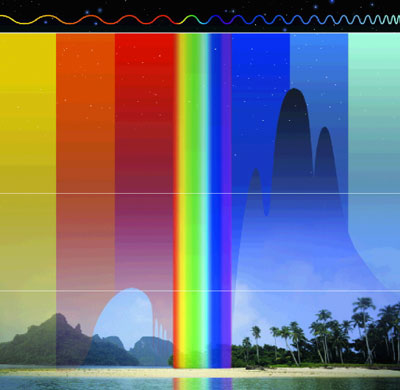Earth's Atmospheric Shield
Electromagnetic radiation bombards Earth from all directions in the universe, the bulk of it from our own Sun. Only certain wavelengths of radiation get through to the surface because Earth's atmosphere reflects, absorbs, or scatters the rest. Oxygen and nitrogen atoms in the thermosphere absorb nearly all x-rays and gamma rays, the most energetic forms of light; the mesosphere and stratosphere screen the remainder. A significant portion of ultraviolet light entering the mesosphere and stratosphere is absorbed by ozone molecules, protecting us from lethal doses. At 10 miles, radiation of longer wavelengths--from visible through radio--enters the troposphere, where water vapor, trace gases, carbon dioxide, dust particles, and pollutants absorb the infrared. Long-wavelength radio waves slide right past these small particles, however, making the radio window one of the most transparent for astronomical observation. |
 |

|
and II telescopes in Hawaii. Both telescopes are over 33 feet across. Each mirror actually consists of 36 hexagonal segments, fitted together in a honeycomb pattern and held steady by hundreds of computer-controlled pistons. These marvels of engineering gather more light in 10 seconds than your eyes could see in three years without blinking. Other telescopes have single mirrors up to 27 feet across  or multiple mirrors that provide even more light-gathering power. This fleet of observatories has ushered in a new golden era of optical astronomy. or multiple mirrors that provide even more light-gathering power. This fleet of observatories has ushered in a new golden era of optical astronomy.
We have also left the ground in pursuit of more photons. Telescopes in orbit around Earth offer two advantages. First, they let us detect electromagnetic energy that the atmosphere blocks from reaching the surface. This includes gamma rays, x-rays, ultraviolet light, and some infrared light. Second, they eliminate the blurring effects  of Earth's blanket of air. The atmosphere is a fluid that sloshes back and forth like water in a pool. Imagine lying on the bottom of a pool and trying to read a sign held above the surface. You could do it if the water was perfectly still, but a tiny splash turns the letters into a muddled mess. By flying above the atmosphere's currents, the Hubble Space Telescope and other orbiting observatories see stars as crisp points rather than twinkling blurs. of Earth's blanket of air. The atmosphere is a fluid that sloshes back and forth like water in a pool. Imagine lying on the bottom of a pool and trying to read a sign held above the surface. You could do it if the water was perfectly still, but a tiny splash turns the letters into a muddled mess. By flying above the atmosphere's currents, the Hubble Space Telescope and other orbiting observatories see stars as crisp points rather than twinkling blurs.
Astronomers have devised a way to erase most of this distortion for ground-based telescopes as well. This still-developing technology, called adaptive optics  , is a key observing strategy of the Keck telescopes and at other big observatories. In one version of adaptive optics , is a key observing strategy of the Keck telescopes and at other big observatories. In one version of adaptive optics  , a laser next to the telescope beams high into the atmosphere to create a small artificial "star." The telescope aims at the laser star, which twinkles just like a real star--thanks to the shifting column of air above the telescope. A computer analyzes this pattern of light and calculates how to cancel out the distortions. Then, a thin mirror inside or next to the telescope carries out those calculations by deforming several times per second. The mirror's rippling shape counteracts the atmosphere's ebb and flow. By the time the light bounces off that mirror and into the observing instruments, it's as if the atmosphere was barely there at all. , a laser next to the telescope beams high into the atmosphere to create a small artificial "star." The telescope aims at the laser star, which twinkles just like a real star--thanks to the shifting column of air above the telescope. A computer analyzes this pattern of light and calculates how to cancel out the distortions. Then, a thin mirror inside or next to the telescope carries out those calculations by deforming several times per second. The mirror's rippling shape counteracts the atmosphere's ebb and flow. By the time the light bounces off that mirror and into the observing instruments, it's as if the atmosphere was barely there at all.
Another way to get more bang for the telescopic buck is to combine light waves from two or more telescopes. The resulting images are sharper than any one telescope can yield. This technique, called interferometry, requires extensive mathematical analysis. Interferometry works best for radio telescopes because radio waves have the
|

